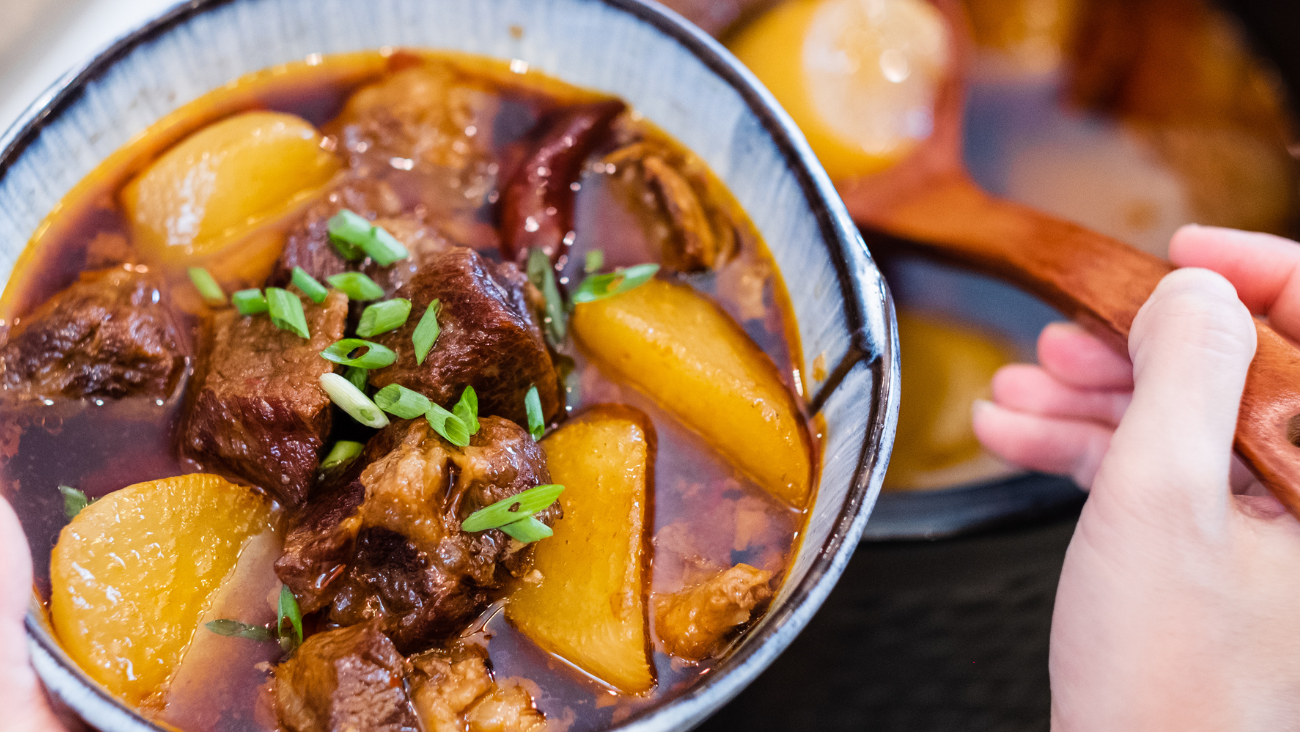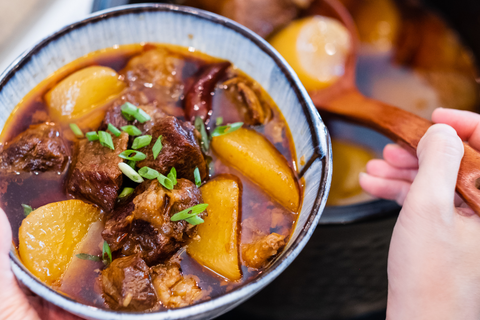Cantonese Braised Beef with Daikon Radish (萝卜炆牛腩)
Rated 3.5 stars by 70 users
Braised beef with Daikon Radish (萝卜炆牛腩) is a classic and popular dish in Cantonese cuisine. You can find it everywhere. In high-end restaurants, they served it as a centerpiece on the table. In fast food places, it is a popular take-out dish. It is so delicious that street food vendors even serve it as a snack. They give it to you in a paper cut. Oh, I used to get those all the time, miss it so much.

Ingredients
To Blanch the Beef
- 2.5 lb 1.13 kg of boneless beef stew meat
- 2-3 liters of water
- 1/4 cup of chinese cooking wine
- 2 scallions
- 2 inches of ginger sliced thinly
- 1/2 tbsp of sichuan peppercorn
To Make the Sauce
- 2 tbsp of Zhu hou paste
- 2 tbsp of hoisin sauce
- 1.5 tbsp of peanut butter
- 1 tbsp of sichuan dou ban jiang
- 2 pieces of Fu ru AKA fermented bean curd
- 3 tbsp of sugar
To Braise the Beef
- 2 tbsp of cooking oil
- 6 cloves of garlic
- 2 inches of ginger sliced thinly
- 1 pieces of star anise
- 2 pieces of bay leaves
- 1 of cinnamon stick
- 1 piece of orange peel
- 4 pieces of gan cao 甘草
- A small piece of dried golango
- A couple pieces of red dried chilies
- 4 tbsp of Soy sauce
- 2 tsp of dark soy sauce
- 4-5 cups 1-1.25 liters of water
- 1/2 tsp of salt or to taste
- 2 lbs 900 grams of Chinese Daikon radish
- Diced scallion as garnish
Products Used
Directions
Cut the beef into 1 inch cubed. You can use boneless beef rib, bone-in short ribs, shank, bottom Sirloin Flap, fatty brisket, oxtail, even beef tendon for this recipe.
- Fill a big pot with water. Add the beef along with the Chinese cooking wine, scallions, ginger slices, and Sichuan peppercorns. Bring it to a boil then skim off all the scrum. Remove the beef from the pot and set it aside.
- Combine all the sauce ingredients thoroughly and set it aside.
- Add oil, garlic, ginger slices, star anise, bay leaves, cinnamon stick, orange peel, Gan Cao, dried Galangal, and red dried chilies to a heavy duty pot (preferably a clay pot, dutch oven, or cast iron pot). Stir over medium heat for a couple of minutes or until fragrant.
- Add the sauce and sauteed for a few minutes to activate the flavor. Add the beef and continue to mix until every piece is well covered.
- Add 4-5 cups of hot water and bring it to a boil. The amount of liquid should be able to cover the beef completely.
- Add soy sauce to taste. Drizzle in some dark soy sauce for the color. Turn the heat to the lowest and let it simmer for 2 hours or until tender.
- 40 minutes before the beef is ready, double-peel the Daikon radish skin then cut it into big chunks. I found that the daikon radish in the USA is not as sweet as the ones that I had in China. It is more on the bitter side and it gives the soup an unbearable bitter after taste. The skin contains more bitter elements, so it is very important to double peel the skin.
- Add the radish into a pot of boiling water and blanch for about 5 minutes to reduce the bitter taste. Transfer the radish into the clay pot. Give it a taste to adjust the flavor again because you want to be accurate after you added the daikon radish.
- Continue to simmer for about 20 minutes. Serve with white rice or noodle.



































































